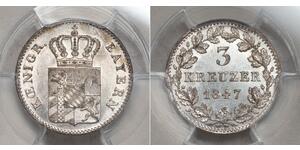5 Mark Kingdom of Bavaria (1806 - 1918) Gold Ludwig II of Bavaria ...
1877, Kingdom of Bavaria, Ludwig II. Rare Gold 5 Mark Coin. (1.99gm)
Mint Year: 1877
Reference: KM-904.
Mintage: 282,500 pcs.
Mint Place: Munich (D)
Denomination: Gold 5 Mark
Material: Gold (.900)
Diameter: 17mm
Weight: 1.99gm
Obverse: Young head of King Louis II (Ludwig II) of Bavaria right. Mint initial (D) below.
Legend: LUDWIG II – KOENIG V. BAYERN
Reverse: Crown of the German Empire above crowned Imperiag German Eagle with shield at chest and star order.
Legend: DEUTSCHES REICH * 1877 * 5 MARK
The Kingdom of Bavaria was a German state that existed from 1806–1918. Elector Maximilian I Joseph of the House of Wittelsbach became the first King of Bavaria in 1806. The monarchy would remain held by the Wittelsbachs until the kingdom’s dissolution in 1918. Most of Bavaria’s modern-day borders were established after 1814 with the Treaty of Paris, in which Bavaria ceded Tyrol and Vorarlberg to the Austrian Empire while receiving Aschaffenburg and parts of Hesse-Darmstadt. As a state within the German Empire, the kingdom was second in size only to the Kingdom of Prussia. Since the unification of Germany in 1871, Bavaria has remained part of Germany to the present day.
 Ludwig II (Ludwig Friedrich Wilhelm; sometimes rendered as Louis II in English) (August 25, 1845 – June 13, 1886) was king of Bavaria from 1864 until shortly before his death. He is sometimes referred to as the Swan King in English and der Märchenkönig (the Fairy tale King) in German.
Ludwig II (Ludwig Friedrich Wilhelm; sometimes rendered as Louis II in English) (August 25, 1845 – June 13, 1886) was king of Bavaria from 1864 until shortly before his death. He is sometimes referred to as the Swan King in English and der Märchenkönig (the Fairy tale King) in German.
Ludwig is sometimes referred to as Mad King Ludwig, though the accuracy of that label has been disputed. Because Ludwig was deposed on grounds of mental illness without any medical examination, and died a day later under mysterious circumstances, questions about the medical “diagnosis” remain controversial.
Ludwig is best known as an eccentric whose legacy is intertwined with the history of art and architecture, as he commissioned the construction of several extravagant fantasy castles (the most famous being Neuschwanstein) and was a devoted patron of the composer Richard Wagner.
View all coins in the group
(3205 X 1597pixels, file size: ~1M)
Posted by: anonymous 2023-10-30
CoinWorldTV 1877, Kingdom of Bavaria, Ludwig II. Rare Gold 5 Mark Coin. (1.99gm) NGC MS63(+) Mint Year: 1877 Reference: KM-904. Mintage: 282,500 pcs. Mint Place: Munich (D) Denomination: Gold 5 Mark Condition: Certified and graded by NGC as MS-63(+) Material: Gold (.900)Dia ...
(740 X 366pixels, file size: ~62K)
Posted by: anonymous 2020-07-05
1877,Bayern. Ludwig II. 1864-1886. 5 Mark 1877 D. Jaeger 195. GOLD. Prüfspur am Rand, sehr schön.
(740 X 364pixels, file size: ~51K)
Posted by: anonymous 2019-05-29
1877,DEUTSCHLAND. Kaiserreich. Bayern, Königreich. Ludwig II. 1864-1886. 5 Mark 1877 D, München. 1.96 g. J. 195. Fr. 3767. Sehr schön-vorzüglich / Very fine-extremely fine. (~€ 220/USD 250)
(740 X 367pixels, file size: ~55K)
Posted by: anonymous 2019-05-29
1877,DEUTSCHLAND. Kaiserreich. Bayern, Königreich. Ludwig II. 1864-1886. 5 Mark 1877 D, München. 1.97 g. J. 195. Fr. 3767. Fast vorzüglich / About extremely fine. (~€ 220/USD 250)
(740 X 367pixels, file size: ~53K)
Posted by: anonymous 2019-05-29
1877,DEUTSCHLAND. Kaiserreich. Bayern, Königreich. Ludwig II. 1864-1886. 5 Mark 1877 D, München. 1.98 g. J. 195. Fr. 3767. Vorzüglich / Extremely fine. (~€ 265/USD 300)
(740 X 367pixels, file size: ~56K)
Posted by: anonymous 2019-05-29
1877,DEUTSCHLAND. Kaiserreich. Bayern, Königreich. Ludwig II. 1864-1886. 5 Mark 1877 D, München. 1.98 g. J. 195. Fr. 3767. Vorzüglich-FDC / Extremely fine-uncirculated. (~€ 440/USD 500)
|
1 Thaler Kingdom of Saxony (1806 - 1918) Silver John of Saxony
group has 51 coins / 50 prices
⇑

-500-250-bbsKbzbiVAcAAAFLb5GjltmE.jpg)
-300-150-dZIhwJflauIAAAGL3mtTnYKg.jpg)
-300-150-F9zcL1dgk3IAAAFzq2HDuSDf.jpg)
-300-150-0cgbmpJTiEcAAAFrUzAhfwXg.jpg)
-300-150-4kEbmpJTZzMAAAFrDiUhfwXg.jpg)
-300-150-guAbmpJTPxoAAAFrSBohfwXg.jpg)
-300-150-2PgbmpJT6BsAAAFrgA8hfwXg.jpg)







-300-150-a2wKX9ISg1oAAAFVFOsLYYS3.jpg)






